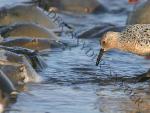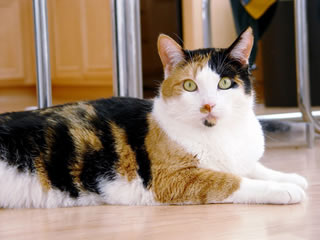
Preview
Material for Exam 3 - Spring 2008
Print
the PDF version (no pictures, better printing)
 source
source
source
 source
sourceIn recent years, human harvesting of horseshoe crabs in the Delaware Bay has led to a great decline in the numbers of spawning crabs. The Atlantic Coastal population of the Red Knot (a shorebird that migrates between wintering areas in Argentina and breeding grounds in the Arctic) is highly dependent on the eggs of spawning horseshoe crabs to supply the nourishment needed for the long flight from Delaware Bay to their Arctic breeding grounds. As an apparent consequence of horseshoe crab harvesting, the number of Red Knots is rapidly declining. For the Atlantic Coastal population of Red Knots, researchers have estimated the birth rate (b) at 1.0 individuals/individual/year and the death rate (d) as 1.5 individuals/individual/year.
 source
source source
sourceCalico (or tortoiseshell-and-white) cats show a unique pattern of coat coloration that usually looks like patches of orange, black, and white fur. The pattern results from alleles for one gene related to coat color that is located on the X-chromosome, and calico cats are almost always female. When the allele that results in black fur occurs on one chromosome and the allele for orange occurs on the other, neither allele is dominant to the other, and a patchwork of black and orange results. (There are other genes involved in coat color as well, but the presence of both “orange” and “black” alleles on the X-chromosomes is the primary determinant of calico coloration.) Due to their rarity and unusual appearance, calico cats are considered good luck in many cultures.
Not many people enjoy wearing spandex body suits in public, but Stephanie Mason does. She is an OSU student who is also one of the fastest women bicyclists in the state for her age group. The night before a bicycle race, you will find Stephanie eating foods that contain large amounts of starch (a carbohydrate), like pasta, bread, and potatoes. This practice is called “Carb Loading” and allows her body to produce stores of glycogen before the race that can be quickly converted to glucose when needed. During the race she drinks CytoMax, a drink containing glucose, protein, and electrolytes. Even though she has been training for this race for months, the mitochondria in her leg muscles run out of oxygen! Stephanie begins to feel fatigued but keeps charging towards the front of the pack. The finish line is in sight! Early in the race, the use of ATP increases in Stephanie’s muscle cells. On the last leg of the race, the demand for oxygen in the mitochondria of her muscle cells is so great that there isn’t enough oxygen to continue making ATP by chemiosmosis.
 source
sourceImagine going to your doctor for a flu shot, and instead you’re handed a slice of banana and told “Eat this.” This could soon be reality now that scientists have developed transgenic plants that produce flu vaccines. Currently the viruses in the flu vaccine that you get at your doctor’s office have most likely been grown inside of a chicken egg. This is a slow, expensive process that makes it difficult to respond to sudden viral outbreaks. According to an article in National Geographic, instead of containing killed viruses like current flu shots, plant produced vaccines contain “protein spikes” from the virus that illicit an immune response from the host.
 source
sourceHelicobacter pylori is a bacterium that is commonly responsible for stomach ulcers. A medical doctor collects a sample of H. pylori from a patient’s stomach and sends it to the lab. A microbiologist then places them in a culture medium to study the bacterial growth. Initially, the microbiologist estimates approximately 120 bacterium are plated. The data collected can be found in the chart below:
Hour |
Number of bacteria cells |
1 |
250 |
2 |
600 |
3 |
1600 |
4 |
4800 |
Consider a population of frogs that have brown coloration. A male frog, which is tan, enters the habitat from a neighboring population and mates with several of the brown females. All of their immediate offspring are brown. After another generation (when those offspring reproduce), some of the frogs in the population are tan, although most are still brown.
 source
source source
source source
source source
source